There are 33 large deserts in the world. Home to some of the most resilient species, deserts are also homes to various species of snakes.
In North America, it’s the US-Mexico deserts that are inhabited by these snakes. In Africa, The Saharan Desert is home to venomous snakes.
The Great Australian is also home to snakes, some being highly venomous.
Asia’s Thar Desert and The Arabian Desert are also areas with known and numerous species of snakes.
While it seems there’s no life in these deserts, there are still snakes that are only found here while others are also found in other climates such as grassland in temperate climates.
Desert Snake Adaptations – how do snakes live in the desert?
Unlike snakes in other regions of the world that get consistent rainfall, snakes in the desert need to adapt to the driest climates in the world. They often go to extreme lengths to survive in the desert. Here’s how they do it.
Living under rocks
The first thing snakes need to do is to seek out a place that’s not in full sun so they can cool off.
While not all snakes do this, species such as The Desert Rosy Boa only live under rocks or in crevices, places with the shade they exit for food alone.
Rock outcrops are among the most common areas of deserts with snakes. These areas provide multiple shade spots for snakes and their most common prey to live in.
Living tens of feet underground
Some snakes even live in the ground, only coming to the surface occasionally.
Western Blind Snakes are an example species of snakes that live in the ground. This is a species that prefers to spend all of its life in the ground.
Many of these low-depth snakes lack vision as they don’t need it. They simply feed on termites and ants in the ground.
Living next to springs
Springs in the desert provide an oasis for different species. There are even snakes that only live next to these small water sources of the desert.
Baja California Rat Snakes are among the snakes that only live next to springs in the desert. It’s here they can find their small prey as well as a higher moisture area they can survive in.
Eating rodents
From gophers to desert kangaroo rats, different types of rodents live in the desert.
Snakes are all carnivorous and they often rely on rodents as their sole food source.
As a result, an area of the desert with a rodent population is always likely to have predators such as snakes nearby as well.
Some venomous snakes constrict these rodents while others subdue them with venom.
Eating other snakes
Highly common in the world of snakes, the juvenile snakes of other species often serve as food for some types of snakes.
This is why there are even deserts where some species of snakes almost exclusively feed on juvenile snakes and the clutch of other snake species.
This is a common habit that may come with adaptations such as resisting the venomous bites of other snakes.
Snakes in the Desert
The following species of snakes are found in some of the most popular deserts of the world.
1. Rattlesnakes

Rattlesnakes are the venomous snakes that bite the most across North America.
Named after the warning rattle at the tip of their tails, these types of snakes are found in high numbers in deserts, across different species.
Arizona black rattlesnake (Crotalus cerberus) is a species of The Sonoran Desert, known for its venomous profile and dark, almost completely black appearance.
Reaching a length of around 30 inches, this desert snake may also be known as The Cerberus rattlesnake.
Mojave rattlesnake (Crotalus scutulatus) is named after The Mojave Desert it lives in. It also lives in the Sonoran and The Chihuahuan Deserts.
Highly venomous, The Mojave Rattlesnake can potentially kill a human with a single bite. They seek out lizards and small rodents, as humans are only rarely bitten.
Colorado Desert sidewinder (Crotalus cerastes laterorepens) is a species of The Sonoran. Known for its side movements, this snake is also venomous.
There’s more rain in The Colorado Desert as opposed to the entire area of The Sonoran which means this snake which means The Colorado Desert has different peak activity periods as opposed to other rattlesnakes of The Sonoran Desert.
2. Desert Rosy Boa

Desert Rosy Boa (Lichanura trivirgata) are bright snakes of The Mojave Desert and of The Colorado Desert.
A non-aggressive snake, Desert Rosy Boas aren’t venomous.
The fact they don’t have any venom and that they live in harsh climates such as the desert limits their self-defense options.
This is the main reason Desert Rosy Boas only live in rocky areas and areas of the deserts with rocks and crevices they hide in.
These are places the snake spends its entire life in. Desert Rosy Boas are dependent on granite hiding spots to stay clear of their potential predators.
It may be easily spotted in open areas as soon as it rains but it prefers to hide in shaded places to avoid the high desert heat.
3. Desert Kingsnake

A species of the Southwestern US deserts, The Desert Kingsnake (Lampropeltis splendida) is a cross-state species found in Arizona, New Mexico, and Texas.
One of the most common species of desert snakes, Desert Kingsnakes are also among the largest types of desert snakes, often reaching lengths of over 6 feet.
These snakes are docile towards humans, despite their large size.
Rarely biting, they even go to extreme lengths to avoid confrontation. This includes tapping into their ability to play dead.
A constrictor, this snake is a powerful species that prefers rodents.
The snake also eats the young venomous snakes it shares its desert climate with. It has been even introduced on farms to limit the spread of other snake species.
4. Desert Death Adder

A species found in the rough desert climates of Australia, The Desert Death Adder (Acanthophis pyrrhus) is highly venomous.
Its neurotoxic venom can kill humans, but bites are rare. A reduction of habitat, particularly in Western Australia also limits its natural area.
Desert Death Adders are also nocturnal, which means actual human encounters are rare.
Even more, unlike other venomous desert snakes, Desert Death Adders only bite when close.
The snake can be tan, bright olive, yellow-green, red, and red-brown. It matches its appearance to its environment which helps its camouflage and hunting capacity.
The snake mostly eats rodents, but it waits for them to come in very close range to trigger the attack.
5. Desert Whip Snake

Desert Whip Snakes (Demansia cyanochasma) are venomous snakes of Australia.
This snake species isn’t dangerous to humans as its venom is only dangerous to small animals, such as reptiles.
Apart from its desert climate, The Desert Whip Snake also stands out with its atypical appearance.
This dual-colored snake has a copper-colored head and tail while its mid-section shows gray-blue colors.
Its copper nuances are the ones to most likely mimic the color of the soils in its natural desert homes.
This is a snake that inhabits vast areas of the desert from The Northern Territories to Southern Australia.
Sometimes spotted by those venturing out the desert during the day, The Desert Whip Snake seeks shelter immediately as it spots humans.
6. Glossy Snake

Native to the Southwestern deserts, The Glossy Snake (Arizona elegans) also lives in parts of Mexico.
This is one of the common but non-venomous snakes of the desert which poses little to no threat to humans.
Mostly focused on eating small lizards, Glossy Snakes are seen in different shades of brown and tan.
This snake may be aggressive in the breeding period, but it doesn’t bite.
Glossy Snakes are the types of snakes that lay eggs, also inside the desert, typically in a secluded location.
A high number of eggs is specific to the bred female Glossy Snake.
This type of snake is rarely seen by humans due to its nocturnal feeding habits.
Unlike many other snakes of the desert, Glossy Snakes can use constriction to kill prey but they can also swallow prey directly.
The most common period to spot these snakes is at the beginning of the summer, a period when the female lays the fertilized eggs.
Up to 20 eggs are typical of the clutch of Glossy Snakes.
Both these eggs and the small emerged juveniles are often seen as prey by other snakes in The Southwestern North American territories.
7. Desert Nightsnake
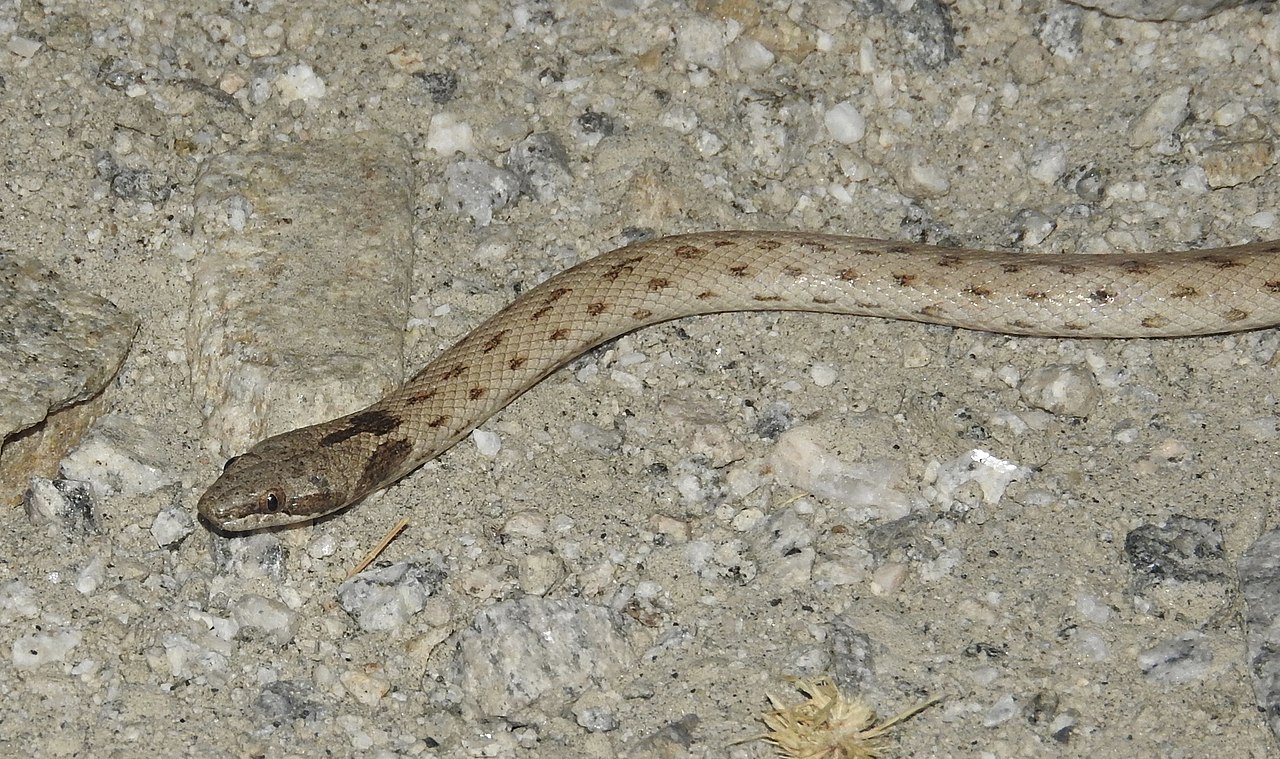
A species of The Sonoran Desert and The Chihuahuan Desert, The Desert Nightsnakes (Hypsiglena chlorophaea) are mildly-venomous.
They don’t bite people and the rare bites that do occur aren’t life-threatening.
Desert Nightsnake venom is life-threatening to small lizards, on the other hand.
This is a species that uses its venom to immobilize its prey before swallowing it.
Mostly seen in various shades of brown, this type of snake is only encountered by humans traveling through the roads within these deserts.
The species is nocturnal, highly likely to look for food at night or to simply rest on the warmed-up roads of the deserts at night.
8. Madrean Mountain Kingsnake

The Mandrean Mountain Kingsnake (Lampropeltis knoblochi) is a small area desert snake found in Northern Mexico.
A species of The Sonoran Desert, this is a snake that mimics more dangerous coral snakes as a means of defense.
Mandread Mountain Kingsnakes are red, black, and yellow instead of red, black, and white as actual coral snakes.
Their body is represented by colorful banding but the white bands seen on the coral snake are cream-yellow on Mandread Mountain Kingsnakes, together with the section of the mouth on its black head.
A species commonly found at the US-Mexico border, Mandread Mountain Kingsnakes take on these colors to keep other snakes away.
Some of their most common predators include The Western Diamondback Rattlesnakes.
9. Western Blind Snake
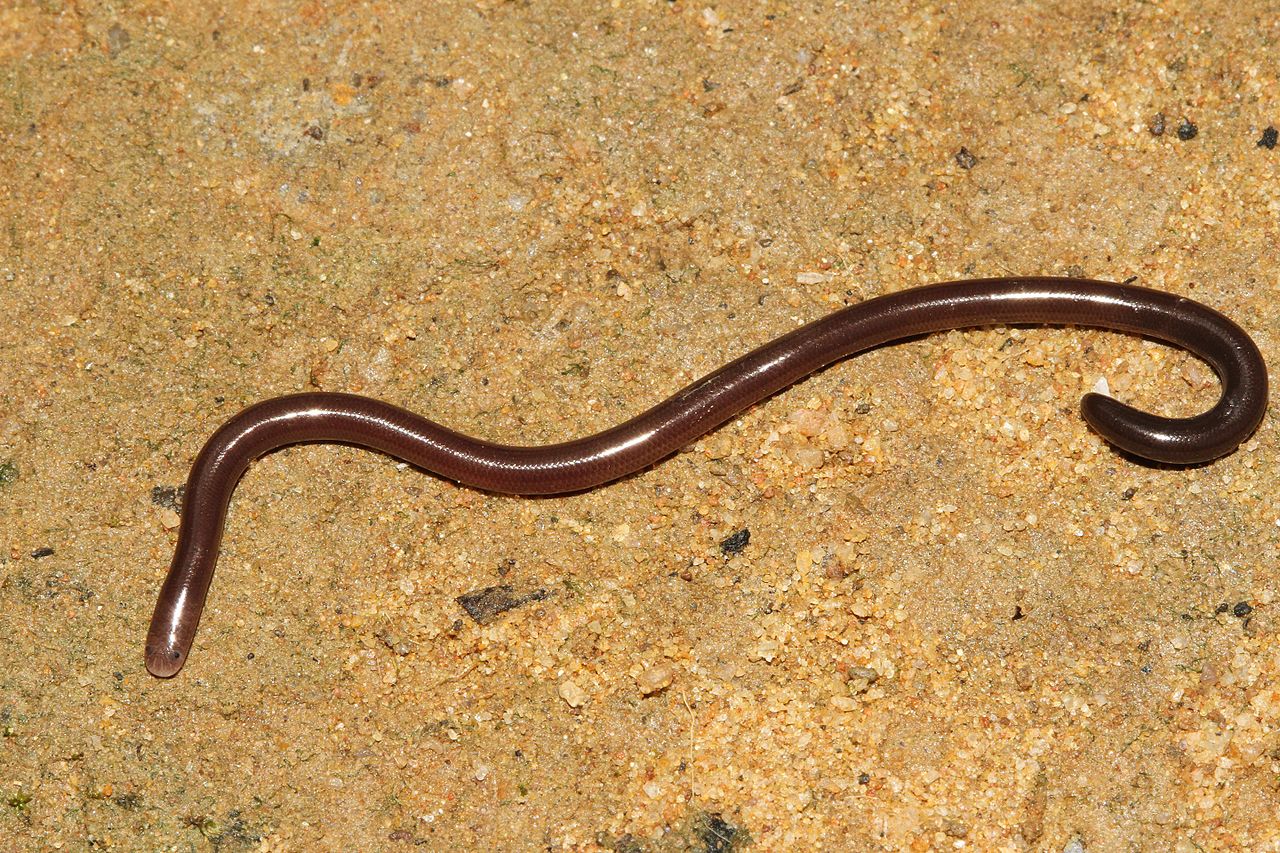
A species of US and Mexico deserts, Western Blind Snakes (Rena humilis) are among the smallest snakes to live in these inhospitable climates.
This snake is blind as it lives underground and has no real use for vision.
It even comes in a unique silver-brown color which may make it resemble some types of earthworms.
The snake itself is even confused with earthworms due to its size and shape.
Even the longest and the oldest Western Blind Snakes never measure more than 12 inches.
To survive in this climate, Western Blind Snakes move deep in the ground, sometimes tens of feet deep.
At these depths, they can still find ants and termites to feed on, or at least find where they place their eggs to feed on them instead.
10. Sahara Sand Viper

A species found in the Northern parts of The Sahara Desert, The Sahara Sand Viper (Cerastes vipera) is a type of pit viper of Africa.
This is a pale color species with faded brown dorsal spots and a widened head.
Sahara Sand Vipers are some of the most efficient predators of North Africa through their hunting techniques.
They can rely on ambushing strategies where they sit and wait for prey for hours or on their active movements to locate prey in the desert.
This venomous snake is also dangerous to humans and it can sometimes be found close to populated areas.
Vipers of this species may not be spotted all year as they enter dormancy together with other species of The Sahara.
11. Desert Cobra

A widespread habitat including desert and even tropical climates is specific to The Desert Cobra (Walterinnesia aegyptia).
As a snake specialized in lizards and other small prey, Desert Cobras may not be perceived as dangerous at first.
However, these snakes are highly venomous and often aggressive.
Sometimes all-black, Deseret Cobras struggle to bite during the day as they don’t have the best vision as nocturnal snakes.
Some of their preferred areas for lizards include bush-rich habitats of deserts.
Desert Cobras are a common sight in Egypt, Saudi Arabia, and other regions of The Middle East.
12. Baja California Rat Snake

A species found in Baja California and The Colorado Desert, The Baja California Rat Snake (Bogertophis rosaliae) is a species adapted to living in harsh habitats.
Nobody knows exactly the type of habitats The Baja California Rat Snakes prefer, but many find it close to springs.
An abundance of food is what may attract it here.
However, this type of snake is also found in rocky and shrub-specific areas of the desert, so it doesn’t exclusively live close to a water source.
A non-venomous type of snake of earthy colors, The Baja California Rat Snake is also a nocturnal species that typically hides when spotting humans.
The species isn’t known to bite. The snake is not venomous either.
13. Desert Banded Snake
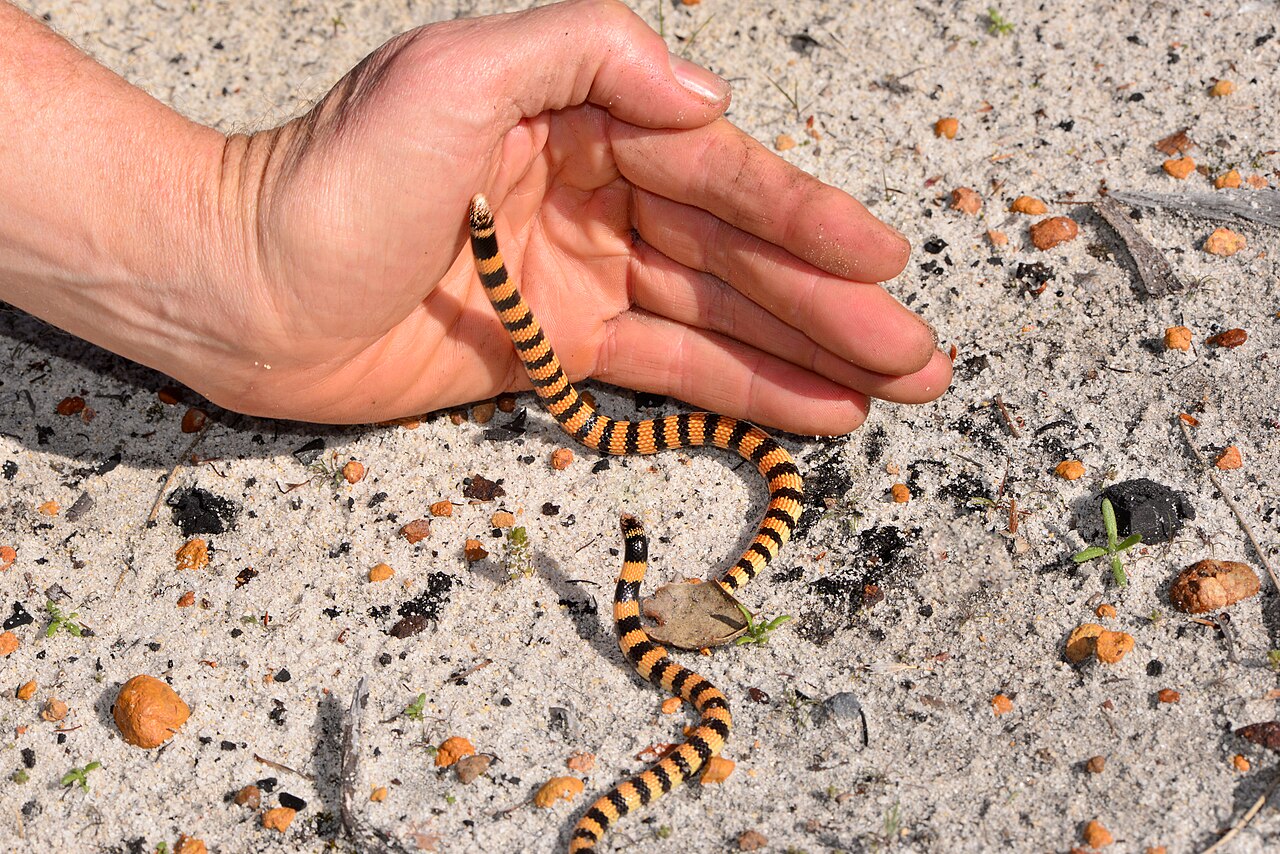
The Desert Banded Snake (Simoselaps bertholdi) is one of the tiniest types of snakes that live in Australia.
Snakes of the species are found in different habitats, from sandy beaches to the hottest areas of the desert.
Desert Banded Snakes are identified by their short stature as they rarely reach a length longer than 10 inches.
They also feature distinct black bands and yellow-orange ground coloring while their ventral color is yellow.
Their heads are also orange and black, with the brightest sections attributed to the areas of the mouth.
Mildly venomous, this small snake relies on its venomous bites to overpower its prey.
14. Sonoran Shovelnose Snake
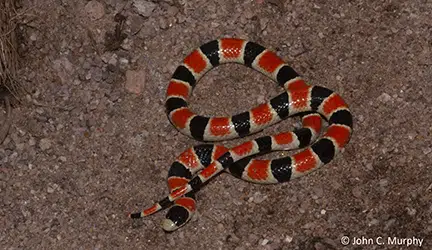
A type of colubrid, The Sonoran Shovelnose Snake (Sonora palarostris) has a banded appearance.
Found in The Sonoran Desert, at the US-Mexico border, this is a type of red, black, and white-cream snake.
Its banded appearance is what makes it stand out in its sandy habitat.
A small species, The Sonoran Shovelnose Snake grows to a maximum length of 15 inches and has a black-and-white appearance as a juvenile and not a colorful appearance from its early days.
The snake is found in areas where water tends to accumulate when it rains. These are habitats with some type of short vegetation as cover and with some animals for the snake to feed on.
15. Trans-Pecos Rat Snake

A bright snake with black dorsal patterns, The Trans-Pecos Rat Snake (Bogertophis subocularis) is mostly found in The Chihuahuan Desert, both in The US and in Mexico.
This is a species that can be quite large, compared to other snakes of this desert and of New Mexico or Texas.
It can reach a length of about 5 feet and can be spotted along rocky areas of the desert.
Mostly nocturnal, the snake is non-venomous and doesn’t bite unless threatened.
The most likely period for it to bite is during the breeding season or when the female lays the clutch. This period extends through the summer.
The non-venomous profile and the non-reactive nature of this snake have also made it a common species to be raised by snake pet enthusiasts.
16. Saharan Horned Viper

While it lives in The Sahara and The Arabian Desert, The Saharan Horned Viper (Cerastes cerastes) doesn’t inhabit the dunes in these terrains.
It lives around the rock outcroppings of the desert which are exposed rock formations where it can hide.
The snake does have a sandy color, on the other hand.
This type of venomous snake is also the subject of many myths based on its atypical appearance.
Short horns are seen on its head and make the snake look a bit scarier than others in its native deserts.
Saharan Horned Vipers are also highly venomous, possibly interfering with normal heart rate when biting.
17. Western Hognose Snake

A non-venomous snake that lives in a variety of habitats, The Western Hognose Snake (Gyalopion canum) is found in The Sonoran Desert.
This is a species known for its brown dorsal blotches and its adaptability to various climates.
It can even live at an elevation of several thousand feet and in grassland, outside its typical desert habitats.
Snakes of the species are adapted to eating small prey such as frogs.
It generally doesn’t jump to bite people as it becomes a defense in the presence of humans.
Western Hognose Snakes are among the multiple Northern and Central American snakes to play dead, an extreme measure they resort to in front of perceived threats.
18. Eastern Kingsnake

Eastern Kingsnakes (Lampropeltis getula) are found in the Southwestern US deserts.
This is not its favorite habitat as the snake is mostly found in grassland and even farmland first, typically in the Eastern and Southeastern parts of the US.
A black snake with black bands, The Eastern Kingsnake can help keep the snake populations low in its habitat.
This is a species that doesn’t back away from eating other juvenile snakes, even if they’re venomous.
They show immunity to the venom of other species and often eat rattlesnakes when they live in deserts.
19. Desert Sidewinding Adder

A short snake that rarely reaches a length of 10 inches, Desert Sidewinding Adders (Bitis peringueyi) are named after the movement patterns.
These bright sand-colored snakes even look like the desert, which means they may not be easily seen by their prey in the desert.
A sand-tan color is specific to these African snakes which additionally feature small black dots on the dorsum.
Spotting them all together can be difficult as Desert Sidewinding Adders spend much of their lives buried in the sand.
Only their head remains above the ground, but even their eyes have a sand color which means it isn’t spotted either.
20. Sidewinder

Found in the deserts of The Southwestern United States, The Sidewinder (Crotalus cerastes) is also a species adapted to fast movements on sand.
Its side movements help the species move forward efficiently, without sinking into the sand.
Some of the ways to read its areas is to analyze the marks in the sand. J-shaped marks are specific to this species.
Sidewinders are also venomous snakes. Much of their venom is considered dangerous to humans, although it is not the most potent venom in the region.
Acute pain is specific with all Sidewinder bites. On the other hand, other reactions require medical attention.
Bruising or other circulatory issues are also specific reactions to its bite.
21. Desert Coralsnake

This snake species (Micrurus tschudii) is also found in the Southwestern US deserts as well as in Mexico.
It lives in deserts but it can also live in grassland and other low vegetation areas. On occasion, Desert Coralsnakes make their way to farms.
They like farms due to the presence of other snakes and rodents as Desert Coralsnakes mostly eat other snakes.
Blind snakes, which are usually smaller, are frequently eaten by these snakes.
A multi-colored type of banded snake in the desert, The Desert Coralsnake is also venomous but rarely life-threatening due to its smaller fangs compared to other snakes.
22. Pacific Gopher Snake

A species rarely found in desert flats, The Pacific Gopher Snake (Pituophis catenifer) is one of the larger species of this habitat.
Its Sonoran subspecies is mostly found in The Sonoran Desert, on the other hand.
These large snakes primarily feed on rodents and lizards here.
A non-aggressive behavior is specific to these snakes which are even a common sight in the snake pet trade industry.
23. Desert Horned Viper

A species of African and Arabian Peninsula deserts, The Desert Horned Viper (Cerastes gasperettii) is among the species with a strange look.
It features 2 short horns which act as warning signals to predators.
Also, a species that moves by sidewinding, this is a highly venomous snake.
It rarely bites due to its remote living but its venom can easily kill a person.
Growing to a length of up to 33 inches, Desert Horned Vipers have a deadly bite that can cause hemorragia.
24. Western Patch-nosed Snake

Rock outcrops, crevices, and rocky areas of The Southwestern US deserts are home to The Western Patch-nosed Snake (Salvadora hexalepis).
This ground color snake features 2 black dorsal stripes that run from the head to the tip of the tail.
Mostly taking the color of its rocky desert grounds, this is a type of snake that’s well adapted to this region.
It can eat snakes, especially juveniles, as well as snake eggs. It also eats lizards which are highly common in the desert.
25. Desert Cat Snake
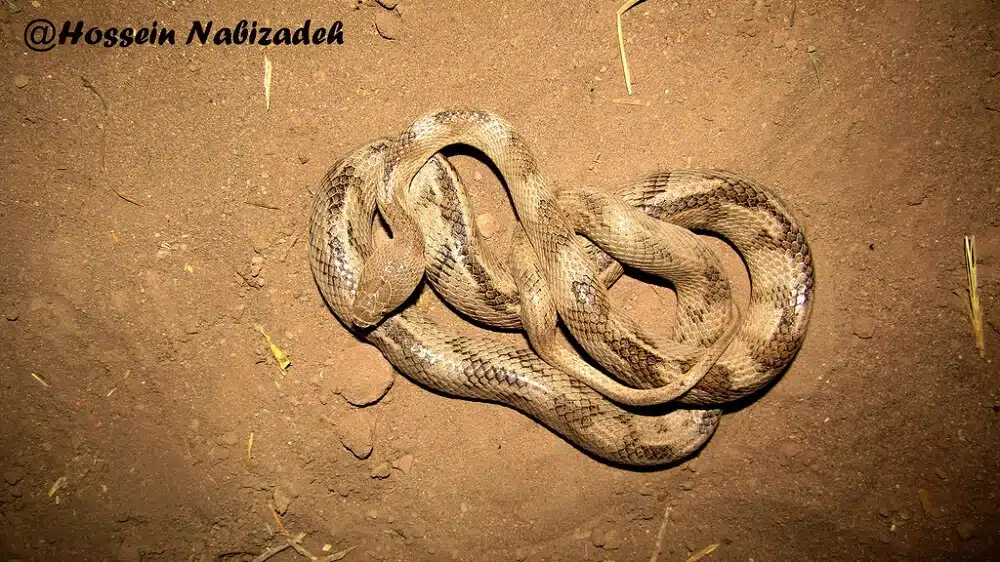
A species of remote Asian desert, The Desert Cat Snake (Telescopus rhinopoma) is mostly found in the arid areas of Pakistan.
Mildly venomous, this snake has a painful bite but it’s believed not to be lethal to humans.
This gray or bright brown snake also features darker dorsal patches, but these colors don’t inspire its name.
It’s the appearance of its eyes that inspires its name as the eyes of the species resemble those of cats.
Gray Desert Cat Snakes are also growing in numbers across Asia, also in different deserts, or in different arid climates.
Reports have these snakes spotted in countries such as Iran or as far from Pakistan as Afghanistan.